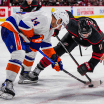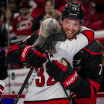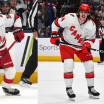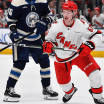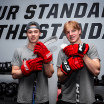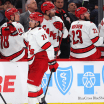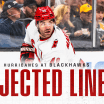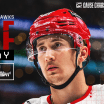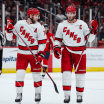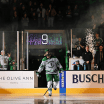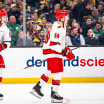Visit Hurricanes.com/Draft for the latest news, videos and pick-by-pick information in the 2020 NHL Draft.
Shortly after 7 p.m. on Tuesday, Oct. 6, inside the NHL Network studios in Secaucus, N.J., Commissioner Gary Bettman delivered opening remarks for the 2020 NHL Draft.
Some 400 miles southeast, the Carolina Hurricanes front office gathered at PNC Arena, where the team's locker room was converted into draft headquarters. Physically distanced and clad in Canes-branded masks around a U-shape of tables included President and General Manager Don Waddell, Director of Player Personnel Darren Yorke, Owner Tom Dundon, Vice President of Hockey Operations Paul Krepelka, Vice President of Hockey Management and Strategy Eric Tulsky and Head Coach Rod Brind'Amour.
The scene was more or less similar for 30 other markets around the league, all connected as one virtual draft floor for an event like no other.
Inside the Canes Draft Room
A glimpse at how the Canes adapted, prepared and executed their plan for the virtual 2020 NHL Draft
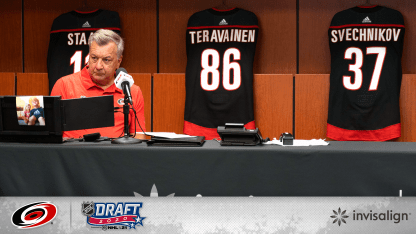
This experience wasn't unexpected, not at least since the COVID-19 pandemic derailed 2020, and since the WNBA, NFL and MLB had all successfully staged virtual drafts earlier in the year, the Canes were able to learn, adapt and prepare for an event that was going to be different in many respects but hopefully familiar, as well.
In the extra months of preparation time leading up to the draft, the Canes worked to ensure the process, for both the team and for the prospects they selected, would best replicate the experience that would have played out at Montreal's Centre Bell in late June.
From a scouting standpoint, the pandemic and the shift to a virtual draft necessitated a heavy reliance upon virtual collaboration through Microsoft Teams. The Canes also established a process to scale scouting efforts with seasons cut short, and postseasons, tournaments and the Scouting Combine all scrapped.
"The one benefit from the pandemic in terms of the draft process is that it gave us more time. It gave us opportunities to take a breath, allow some of the emotions to subside and make better decisions," Yorke said prior to the draft. "When you're able to get more information and slow things down, you're able to make better decisions. I think our group did an excellent job with the circumstances. From a meetings and information-gathering perspective, we're as prepared if not more than any other draft year."
From a draft experience standpoint, the Canes aimed to capture the essence and excitement of draft day and share that with their newest prospects, leaning into the virtual aspects of the event to ensure an immediate connection to the team.
Working in collaboration with the marketing and PR departments, the Canes created hype videos that featured scenic shots of Raleigh, Canes highlights and voiceover work from Andrei Svechnikov, a budding young star and a second overall pick from two years ago. Personalized touches for each video included shots of the prospect's name on the back of the Canes' red home jersey and highlights of the prospect.
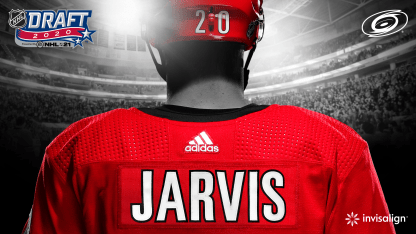
These bespoke videos were shared with each prospect shortly after the draft, a one-of-a-kind memento in a one-of-a-kind year.
"You see the athlete's excitement and the parents' enjoyment and the emotion on their faces, it's something that never gets old," Yorke said. "We wanted to build a connection right away with the athletes, to ensure they're not losing out on the experience of being drafted had they been able to be in Montreal."
On the night of the first round, anxious energy flowed throughout the Canes locker room. Months and months and even more unexpected months of preparation was leading to this, and all anyone could do was simply hurry up and wait.
A catered Angus Barn dinner helped abate some nerves. Meanwhile, Waddell, along with Director of Communications and Team Services Mike Sundheim and a two-person video crew discussed the black third jerseys in the background of the camera shot. Which player's jersey should go where? After Waddell announced the pick, would the camera pan up to reveal the nameplate in the stall behind him, or would he slide it in himself?
"I think you need to worry about making the right pick," Brind'Amour ribbed Waddell.
With the first overall pick in the 2020 NHL Draft, the New York Rangers were on the clock. It was going to be Alexis Lafrenière. That much had been known for months, but the made-for-TV event played up the drama of each selection by letting the five-minute clock tick down.
"What's taking them so long?" chuckled Peter Karmanos Jr., who was in town for the first round.
As picks came off the board, so too did names disappear from the Canes' master draft list, which was displayed on a television screen to Waddell and Yorke's left. On a screen to the right was the world TV feed of the draft. On the TV at the front of the room, the Canes flipped between the big board of picks and the NBCSN broadcast.
The Buffalo Sabres selected Jack Quinn with the eighth overall pick.
"There hasn't been a surprise yet," Yorke said.
Iaroslav Askarov, the highly-touted, top-rated goaltender of the 2020 class, was still available, and there had been no movement up or down the draft board.
"If you hear a trade announced, you know someone is trading up to get the goalie," Waddell said.
Marco Rossi to Minnesota. Cole Perfetti to Winnipeg. Nashville finally nabbed Askarov with the 11th overall pick. Had he still been available two picks later, the Canes would have had a decision to make.
"That settles that, huh?" Karmanos said.
As Florida debated their pick at 12th overall, the Canes keyed into the best player available on their board: Seth Jarvis, who they had ranked in their top 10.
Yorke and the Canes were ecstatic
.
"He's a great kid," Yorke said to Karmanos.
The Canes couldn't officially submit the pick into the system until they were on the clock, but there was no hesitation.
"Congrats on all your hard work," Yorke told his scouting staff, who were connected from around the globe via a video call on Microsoft Teams. "We just took Seth Jarvis."
Sundheim attempted to slide Jarvis' nameplate into the holder in a corner locker stall, but it wouldn't quite fit, so he had to shave the top of it ever so slightly. That, along with the team's draft hat and third jersey, served as the backdrop for a FaceTime call with the newest member of the organization.
"We got you a spot but you gotta go earn it."
"I'm super excited," a smiling Jarvis said. "Thank you guys so much."
Brind'Amour motioned over to the stall and Jarvis' nameplate.
"Now you've got to go earn it, right? Brind'Amour said.
A landline phone connection at Waddell's draft workstation, which also included his laptop and two additional screens with a photo of his grandkids taped to the back, was eerily quiet all of Tuesday night.
Coming into the virtual draft, Waddell thought that might be the case.
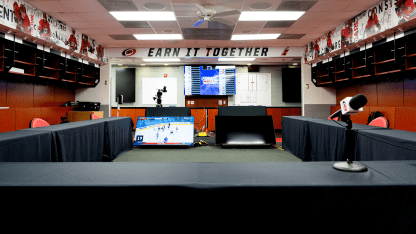
"It's going to be way different. I like to work in person. I've made a lot of deals on draft day over my years. You like to be able to read people and see what they're thinking" he said before the draft. "I think some things may go by without being able to be done because of not being in the same room."
Later in the first round, Waddell left the room. His landline rang.
Brind'Amour went running to grab Waddell, only to find the Canes' general manager prank calling his own phone.
The phone lines were much more active on Wednesday, Oct. 7, a marathon day two of the 2020 NHL Draft.
The Canes began the morning by entertaining trade talks with the New York Rangers and Ottawa Senators, who were both interested in the 41st overall pick. Early in the second round, Los Angeles entered the picture as another suitor, but the Canes were increasingly intrigued by the options on their draft list.
Waddell floated a trade scenario that involved moving down a few spots and collecting a late-second-round pick in the process.
"I'd take the pick," Yorke said. Brind'Amour, in agreement with Yorke, gave a thumbs down to the offer.
So, the Canes made the pick and snagged Noel Gunler, a player
many had ranked as a first-round talent
.
"I know it sounds cliché when teams say they don't expect a player to be there, but we really didn't,"
Yorke said on a media call later
. "So, for us to get a player who has that speed and skill and hockey sense in the second round wasn't something we expected."
Just as they did with Jarvis the night prior, the Canes wanted to contact Gunler as soon as possible.
"Is he playing a game or in practice?" Sundheim asked, a query never before considered in a draft. As it turned out, Gunler did have practice, but that had taken place earlier in the morning in Sweden after a restless, abbreviated night of sleep.
Waddell and Brind'Amour chatted via FaceTime with Gunler, who was celebrating his 19th birthday.
Imagine celebrating your 19th birthday by FaceTiming with Rod Brind'Amour and Don Waddell
— Carolina Hurricanes (@Canes) October 7, 2020
So cool for Noel Gunler pic.twitter.com/z2jL3QruRs
"I like that kid. He was excited," Brind'Amour said afterward. "Great job, Darren."
The Canes fielded more trade offers for pick No. 53 but again elected to hang onto it, using it to select Russian center Vasiliy Ponomarev, who would ink his three-year, entry-level contract just a week later.
After selecting stout Russian blueliner Alexander Nikishin with the 69th overall pick, the Canes had some time to kill, as they weren't slated to make another selection until No. 115.
They chatted with Minor-League Goalie Consultant Paul Schonfelder about the options available in net, but a run of goaltenders early in the fourth round - four in a span of 12 picks - took potential targets off the board. Waddell worked the phones, listening to various trade chatter. Would the Canes be interested in moving up from No. 115? Not really, was the consensus.
Diminutive but skilled forward Zion Nybeck was the Canes' pick at 115th overall. NHL Central Scouting listed him at 5-foot-6, but Yorke said Nybeck was inching closer to 5-foot-8 now.
"I'm on board with it," Dundon insisted. "I just think it's funny he's 5-7."
Though size was a popular point of discussion and an occasional punchline in the room on day two, the
Canes' drafting strategy was predicated on a high level of hockey sense
and the ability to effectively play the modern, possession-driven, transitional game - regardless of position or size or various other attribute.
Later, talk turned to a player who was listed at 5-foot-10.
"He's too tall for us," Yorke joked.
"He's a giant!" Dundon added.
When the best player available on the Canes' list came off the board before they were set to make the 140th overall selection, they reassessed their strategy. Trading down was suddenly a viable option, so Waddell picked up the phone.
They ended up striking a deal with Los Angeles to move back 19 picks to No. 159 and add a seventh-round selection in 2021. And, in the end, they nabbed who they wanted in the first place: sizeable center Lucas Mercuri.
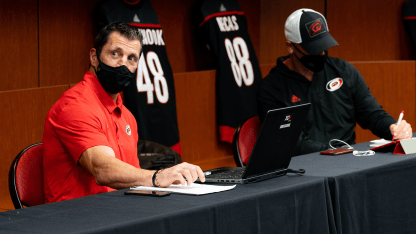
Restlessness set in as the second day of the draft dragged on.
A counterpart joked with Waddell that "some of these players are going to be retired by the time the draft is over."
Collective groans echoed through masks when a timeout was called in the last round.
Waddell, in the midst of it all, continued to work the phones.
"Oh, you want one of my sevenths next year?" he asked. "Holy mackerel, call me next year!"
It was around 7 p.m. on Wednesday when the Canes made their final pick, the 208th overall selection, of the 2020 NHL Draft. That came some six-and-a-half hours after they made pick No. 41, their first of what turned out to be a long, but productive day.
"This is what we live for,"
Waddell said on a media call before the beginning of the final round
. "This is what our scouts have worked for all year, so whether it takes four hours or 10 hours, we're going to be prepared to make the next selection."
As business wrapped, Waddell brought a glass of red wine over to the Microsoft Teams chat with the team's scouting staff.
"A little toast for you guys for all your hard work," Waddell said.
Cheers.
"Now it's time to go back to work on the 2021 draft," Yorke said, as he exited the locker room.
That could at least wait until the next morning.

